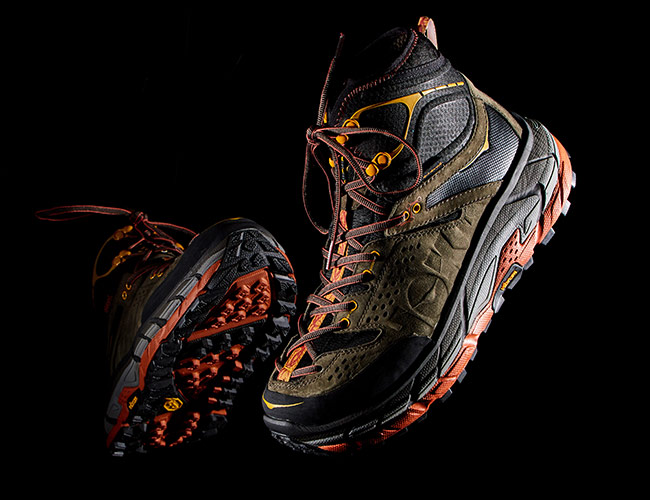Walk into an REI or your local outdoor store, head past the racks of clothing, weave through the displays of headlamps and titanium cutlery, duck under the hanging down sleeping bags — you’re going to the back, to the shoe wall, and you’d be forgiven for turning around and walking back through the store and out the door after getting there.
In gear stores, we’re faced with the same issue that we come against in the supermarket: too many choices. Only here, the purchase is an expensive pair of footwear that we’ll live with for years instead of a too-sweet jar of jam. It’s true for hiking footwear in particular. Not only are there countless brands to choose from but there is also a multitude of types of footwear offered for walking in the woods, mountains and deserts. There are hiking boots, but then there are backpacking boots and multi-use boots and hiking shoes; mountaineering boots, approach shoes, trail running shoes — even hiking sandals.
These vast choices can be paralyzing. In 2004, psychologist Barry Schwartz popularized the idea of “the paradox of choice,” theorizing that when faced with too many options we become more anxious, less happy and sometimes end up avoiding the decision altogether. The way to avoid the trap, he claims, is to rid ourselves of the notion of a perfect choice settle for “good enough.”
It doesn’t have to be this way, not at the gear store shoe wall. The quantity of hiking footwear options shouldn’t be the reason that you continue to journey to summits in unsupportive sneakers that are falling apart from overuse. With just a few thoughtful considerations, you can have a better pair of boots.
1Consider the type of hiking you do. Every person’s needs and walking habits are different. Peter Limmer, a maker of super-rugged custom leather hiking boots, once told me “You can’t get away with being up on Mt. Washington with Five Fingers,” referring to New Hampshire’s tallest mountain and a pair of minimalist, barefoot-style shoes. His example is easily codified into a general rule of thumb: the boots you choose should match the type of hiking you do.
2Choose a type of boot. Whether you’re a long-distance hiker, a day hiker or a casual walker will affect the shoe you should buy. Go more granular: do you prefer something fast and light or something substantial and supportive? Seasoned thru-hikers might hike hundreds of miles in a pair of trail running shoes, while an infrequent, city-based hiker might opt for something with ankle support, even for short trails. Despite what Limmer said, some intrepid mountain runner has probably gone to the summit of Washington in a pair of Five Fingers.
3Go to the store and try them on. There are plenty of lists that will tell you all about the best hiking boots available. These are a starting point only — there’s nothing wrong with a well-researched list, but every person’s feet are different, and you won’t know how a pair of boots feels on your feet until you try them on. Narrow down the options to what sounds good to you based on the previous two steps and make your own list of boots to try. Then you can go to your local gear shop and approach the shoe wall with confidence. (Or forget the online lists entirely and head straight to the store).
Once there, don’t be afraid to try on as many pairs as it takes to find the right boot. Ask questions. Walk around in them and consider any pressure points. Most outdoor stores will have a ramped box that you can use to see what it feels like walking up and down inclines — use it. You’re looking for something that’s snug but not restrictive — make sure your heel doesn’t slide or lift and that your toes have room to wiggle. More than anything, you’re looking for comfort.
Note: If you already have custom insoles (more on that below), make sure to bring them. Try on each pair with the insoles inside.
4Buy insoles. Almost every hiking boot and hiking shoe comes with a foam insole that will wear out after far fewer uses than you’d expect (especially after spending over $200 on a pair of boots). Some are better than others, and most will feel comfortable straight out of the box, but none will provide the long-term support of an aftermarket insole.
Insoles can achieve various purposes: provide additional support, fill up more volume, provide more comfort. Superfeet is one brand that makes a variety of affordable insoles that accomplish these aims. As with the boots themselves, it’s best to try these on at a store to find the most comfortable and best-fitting option. Bring your boots with you, because insoles can change the amount of space inside your shoe and affect the overall feel of its fit.
A Parting Thought
Hiking boots aren’t the same as a pair of running shoes, which have a lifespan denoted in miles ran. Think about them as an investment; the best of them will only get better and more comfortable with time.
Unlike concrete sidewalks and gravel paths, the trail calls for hardened and supportive footwear to combat dirt, mud, jagged rocks and streams. The answer is hiking boots and hiking shoes, and these are the best available. Read the Story




